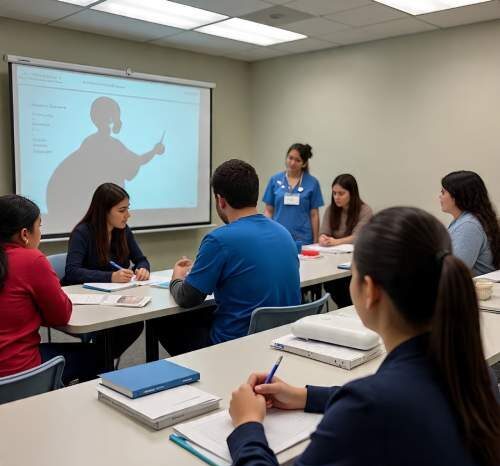Nursing Diagnosis Made Easy: How to Write Nursing Diagnosis with Examples as a Nursing Student (2025 Ultimate Guide)
how to write nursing diagnosis with examples as a nursing student?

Are you struggling to understand how to write nursing diagnosis with examples as a nursing student? You’re not alone. In this 2025 ultimate guide, we break down nursing diagnoses in a simple, step-by-step way—perfect for students who want to master this essential nursing skill. You’ll learn exactly what a nursing diagnosis is, how it fits into the nursing process, and why it’s so important in creating effective care plans. We’ll also explore the history, key classifications, and types of nursing diagnoses, with clear examples and templates to help you write your own with confidence.

This comprehensive tutorial includes practical tips for writing better nursing diagnoses, along with real-life examples and care plan applications. Whether you’re preparing for your exams or clinical rotations, this guide is designed to make nursing diagnoses easier to understand and apply—no matter your level of experience.
What Is a Nursing Diagnosis?
A nursing diagnosis is a clinical judgment made by nurses about how a patient responds—physically, emotionally, mentally, or spiritually—to a health condition or life process. Unlike medical diagnoses that focus on diseases, nursing diagnoses address the patient’s experience of those health conditions. These responses could be actual issues or potential problems that the nurse is responsible for managing. Nursing diagnoses are developed after a thorough nursing assessment and serve as the foundation for creating personalized care plans and guiding appropriate nursing interventions.
Why Nursing Diagnosis Matters for Students
For nursing students learning how to write nursing diagnosis with examples, understanding its purpose is essential. Nursing diagnoses sharpen your ability to think critically and make informed decisions in patient care. Here’s why they are important:
-
Builds clinical reasoning: Helps students apply their knowledge in real-life situations.
-
Prioritizes care: Identifies the most urgent needs so care can be focused and effective.
-
Improves communication: Provides a standardized language for documenting and discussing patient needs with the healthcare team.
-
Supports care planning: Forms the core of individualized nursing care plans.
-
Facilitates evaluation: Allows nurses to track outcomes and adjust interventions as needed.
-
Ensures quality and accountability: Meets professional and legal standards of practice.
How to Calculate Drug Dosage Safely For Nurses in the US 2025– Stop Making Life-Threatening Mistakes
Nursing Diagnosis vs. Medical Diagnosis vs. Collaborative Problems
It’s crucial for students to clearly differentiate between nursing diagnoses, medical diagnoses, and collaborative problems:
-
Nursing Diagnosis: Focuses on the patient’s response to a condition. For example, if a patient shows signs of anxiety, difficulty sleeping, or fear, you might label those as Anxiety, Disturbed Sleep Pattern, or Fear—all of which are nursing diagnoses. These are within the nurse’s scope to manage and are used to guide nursing-specific interventions.
-
Medical Diagnosis: Determined by a physician or advanced provider, this identifies the actual disease or medical condition, such as Diabetes Mellitus, Pneumonia, or Fractured Femur. Nurses don’t treat the disease directly but carry out care based on the physician’s orders related to it.
-
Collaborative Problems: These are potential complications that require both medical and nursing attention. For instance, a nurse may monitor for signs of infection in a postoperative patient and act quickly based on physician-prescribed guidelines. This involves shared responsibility.
Classification of Nursing Diagnoses: Understanding Taxonomy II
As a nursing student learning how to write nursing diagnosis with examples, it’s important not just to understand what a nursing diagnosis is—but also how it’s organized in professional practice. To ensure consistency in clinical reasoning and documentation, nursing diagnoses are classified using a standardized structure known as Taxonomy II, developed by NANDA International (NANDA-I).
What Is Taxonomy II?
Adopted in 2002, Taxonomy II organizes nursing diagnoses using a comprehensive, multi-level system based on the Functional Health Patterns framework originally created by Dr. Mary Joy Gordon. This classification system helps nurses accurately identify, group, and apply diagnoses based on patient needs. Instead of grouping by symptom patterns, modern diagnoses are now arranged alphabetically and coded using seven distinct axes:
-
Diagnostic concept
-
Time (acute/chronic)
-
Unit of care (individual, family, community)
-
Age
-
Health status
-
Descriptor
-
Topology (location or focus of care)
Structure of Taxonomy II: Domains and Classes
Taxonomy II is organized into three hierarchical levels:
-
Domains (13 total) – broad areas of patient function
-
Classes (47 total) – subdivisions within each domain
-
Individual Nursing Diagnoses – specific diagnoses grouped under relevant classes
Below is a simplified overview of the 13 NANDA-I domains and their corresponding classes:
Domain 1: Health Promotion
-
Health Awareness
-
Health Management
Domain 2: Nutrition
-
Ingestion
-
Digestion
-
Absorption
-
Metabolism
-
Hydration
Domain 3: Elimination and Exchange
-
Urinary Function
-
Gastrointestinal Function
-
Integumentary Function
-
Respiratory Function
Domain 4: Activity/Rest
-
Sleep and Rest
-
Activity and Exercise
-
Energy Balance
-
Cardiovascular and Pulmonary Responses
-
Self-care
Domain 5: Perception/Cognition
-
Attention
-
Orientation
-
Sensory and Perceptual Function
-
Cognitive Function
-
Communication
Domain 6: Self-Perception
-
Self-Concept
-
Self-Esteem
-
Body Image
Domain 7: Role Relationships
-
Caregiving Roles
-
Family Dynamics
-
Role Performance
Domain 8: Sexuality
-
Sexual Identity
-
Sexual Function
-
Reproductive Health
Domain 9: Coping/Stress Tolerance
-
Post-Traumatic Responses
-
Coping Mechanisms
-
Neurobehavioral Stress
Domain 10: Life Principles
-
Values
-
Beliefs
-
Value-Belief Congruence
Domain 11: Safety/Protection
-
Risk for Infection
-
Physical Injury
-
Violence
-
Environmental Hazards
-
Defensive Responses
-
Thermoregulation
Domain 12: Comfort
-
Physical Comfort
-
Environmental Comfort
-
Social Comfort
Domain 13: Growth and Development
-
Physical Growth
-
Developmental Progress
Why Classification Matters for Students
For nursing students, understanding the classification system makes it easier to select the correct nursing diagnosis and develop more accurate care plans. By referring to Taxonomy II, you ensure your diagnoses align with evidence-based standards and are clearly understood across healthcare settings.

The Nursing Process and Its Role in Writing Nursing Diagnoses
To master how to write nursing diagnosis with examples for students, it’s essential to understand where nursing diagnoses fit within the broader nursing process. This systematic, patient-centered approach consists of five key steps:
-
Assessment
-
Diagnosis
-
Planning
-
Implementation
-
Evaluation
Each step builds on the other and requires strong critical thinking skills. Once a nurse gathers and analyzes patient data during the assessment phase, the next step is to identify and label the patient’s response using accurate nursing diagnoses. These diagnoses serve as the basis for planning targeted interventions that improve patient outcomes.
In this stage, the nurse also considers defining characteristics (such as signs and symptoms), contributing factors, and appropriate responses. A well-constructed diagnosis leads to more personalized and effective care.
Types of Nursing Diagnoses (With Examples)
NANDA International classifies nursing diagnoses into four main categories: Actual, Risk, Health Promotion, and Syndrome. Additionally, there is a fifth informal category—Possible Diagnosis—used when more data is needed.
1. Problem-Focused (Actual) Nursing Diagnosis
This type of diagnosis identifies current health problems that a patient is experiencing at the time of assessment. It is supported by clear signs and symptoms. Actual diagnoses include three components:
-
The diagnostic label
-
Related factors (causes or contributors)
-
Defining characteristics (evidence or clinical cues)
Examples:
-
Anxiety related to upcoming surgery as evidenced by restlessness and verbalized concern
-
Acute Pain related to surgical incision as evidenced by facial grimacing and guarding behavior
2. Risk Nursing Diagnosis
A risk diagnosis is made when a patient is vulnerable to developing a health issue. Although the problem doesn’t exist yet, risk factors make it likely to occur unless preventive action is taken. These diagnoses do not include defining characteristics because the issue hasn’t happened yet. Instead, they include:
-
A risk diagnostic label
-
Risk factors (linked using “as evidenced by”)
Examples:
-
Risk for Infection as evidenced by open surgical wound and compromised immunity
-
Risk for Falls as evidenced by poor balance, muscle weakness, and previous fall history
-
Risk for Injury as evidenced by confusion and use of sedative medication
3. Health Promotion Diagnosis
A health promotion diagnosis (or wellness diagnosis) indicates a patient’s readiness to improve their health and adopt healthy behaviors. These are used when a person expresses interest in learning or enhancing their well-being. This diagnosis often appears as a one-part statement, though it can be expanded for clarity.
Examples:
-
Readiness for Enhanced Knowledge as evidenced by asking questions about disease management
-
Readiness for Enhanced Breastfeeding as evidenced by verbal interest in breastfeeding techniques
-
Readiness for Enhanced Comfort as evidenced by desire to explore pain relief methods
4. Syndrome Diagnosis
A syndrome diagnosis reflects a collection of related actual or risk diagnoses that tend to occur together due to a specific condition or event. These diagnoses are typically written as one-part statements and don’t require related factors or characteristics.
Examples:
-
Chronic Pain Syndrome
-
Post-Trauma Syndrome
-
Frail Elderly Syndrome
5. Possible Nursing Diagnosis (Informal Category)
A possible diagnosis is used when a nurse suspects a problem but lacks enough information to confirm it. This type signals the need for further assessment. It is not part of the official NANDA categories but is useful for clinical judgment and communication.
Examples:
-
Possible Social Isolation
-
Possible Chronic Low Self-Esteem
Components of a Nursing Diagnosis (PES Format Explained for Students)

When learning how to write nursing diagnosis with examples, it’s important to understand the structure of a nursing diagnosis. A properly written diagnosis helps guide the entire care plan and ensures that nursing interventions are accurate and effective.
Most nursing diagnoses consist of three main components:
-
Problem (Diagnostic Label)
-
Etiology (Related Factors or Risk Factors)
-
Defining Characteristics (Signs and Symptoms)
This structure is commonly referred to as the PES format — P for Problem, E for Etiology, and S for Signs/Symptoms. Let’s explore each part in detail.
1. Problem (Diagnostic Label)
The problem statement, also known as the diagnostic label, identifies the patient’s health issue or response that nurses can address independently. It reflects a clinical judgment based on the patient assessment.
The diagnostic label often contains two parts:
-
A qualifier (e.g., Impaired, Ineffective, Risk for)
-
The focus of the diagnosis (e.g., Gas Exchange, Tissue Perfusion, Injury)
Examples of qualifiers and their focus:
| Qualifier | Focus of Diagnosis |
|---|---|
| Deficient | Fluid Volume |
| Imbalanced | Nutrition: Less Than Body Needs |
| Impaired | Gas Exchange |
| Ineffective | Tissue Perfusion |
| Risk for | Injury |
Note: Some diagnostic labels are one word and don’t require a qualifier (e.g., Anxiety, Nausea, Diarrhea).
2. Etiology (Related Factors)
The etiology describes the underlying cause or contributing factors for the nursing diagnosis. It is introduced by the phrase “related to” in a nursing diagnostic statement. Etiology helps nurses tailor interventions to treat or manage the cause of the issue.
Examples:
-
Activity Intolerance related to generalized weakness
-
Decreased Cardiac Output related to abnormal blood profile
In actual diagnoses, the etiology pinpoints the reason why the problem exists.
In risk diagnoses, the etiology is replaced by risk factors.
3. Defining Characteristics or Risk Factors
These are the observable signs and symptoms that confirm the presence of an actual nursing diagnosis. For risk diagnoses, this component includes factors that increase the patient’s vulnerability to a potential problem.
This section typically begins with “as evidenced by” or “as manifested by.”
Examples for Actual Diagnoses:
-
Anxiety related to upcoming surgery as evidenced by restlessness and verbalized fear
-
Acute Pain related to incision site as evidenced by facial grimacing and guarding behavior
Examples for Risk Diagnoses:
-
Risk for Infection as evidenced by surgical wound and suppressed immune response
-
Risk for Falls as evidenced by muscle weakness and history of previous falls
How to Write a Nursing Diagnosis
Writing a nursing diagnosis involves summarizing patient data into a concise, structured statement using the PES format. The number of parts depends on the type of diagnosis:
Three-Part Statement (PES Format)
Used for actual nursing diagnoses:
-
Problem + related to (etiology) + as evidenced by (signs/symptoms)
Example:
Impaired Physical Mobility related to joint stiffness as evidenced by limited range of motion and difficulty walking.
Two-Part Statement
Used for risk diagnoses:
-
Problem (risk label) + as evidenced by (risk factors)
Example:
Risk for Infection as evidenced by open wound and diabetes.
One-Part Statement
Used for health promotion or syndrome diagnoses:
-
Problem only (no related factors or symptoms required)
Examples: -
Readiness for Enhanced Knowledge
-
Frail Elderly Syndrome
The Diagnostic Process: Step-by-Step
Creating an accurate nursing diagnosis involves the following three steps:
-
Analyze Patient Data
-
Compare findings with standards
-
Group related cues
-
Identify patterns or inconsistencies
-
-
Identify Health Problems, Risks, and Strengths
-
Determine whether the issue is an actual problem, a risk, or a strength
-
Confirm whether it’s a nursing, medical, or collaborative problem
-
Recognize patient abilities and resources
-
-
Formulate the Diagnostic Statement
-
Use the PES format as a guide
-
Make sure the statement is clear, specific, and relevant to the patient’s condition
-
Prioritize based on urgency and patient goals
-
Diagnostic Process: How to Accurately Formulate a Nursing Diagnosis

Now that you understand the components of a nursing diagnosis and how to structure them using the PES format, let’s walk through the diagnostic process—the critical thinking steps that help you move from patient data to an accurate nursing diagnosis. As a nursing student, mastering this process is essential in learning how to write nursing diagnosis with examples that are clinically sound and care-focused.
This process includes three essential phases:
1. Analyze Collected Data
The first step is to review and interpret all assessment data. This includes:
-
Identifying patterns and clusters of related information (e.g., vital signs, behaviors, physical findings)
-
Comparing data against normal standards
-
Noting any inconsistencies or abnormalities
This phase helps you determine which signs and symptoms are significant and which ones may be unrelated.
2. Identify Health Problems, Risks, and Strengths
After analyzing the data, work with the patient (if possible) to determine:
-
Actual health problems (current issues requiring nursing intervention)
-
Potential risks (problems the patient is vulnerable to developing)
-
Patient strengths and resources (abilities or support systems that can assist in recovery or health improvement)
It’s also important to distinguish whether the issue is something a nurse can address independently (a nursing diagnosis), something that requires a medical diagnosis, or a collaborative problem needing both nursing and medical intervention.
3. Formulate the Nursing Diagnostic Statement
Once you’ve identified the problem, it’s time to write the diagnosis using the appropriate format based on the diagnosis type:
-
Use the PES format for actual problems
-
Include risk factors for risk diagnoses
-
Use a simple, one-part label for health promotion or syndrome diagnoses
Examples by diagnosis type:
| Diagnosis Type | Format Used | Example |
|---|---|---|
| Actual | Problem + related to + as evidenced by | Ineffective Breathing Pattern related to airway obstruction as evidenced by shortness of breath and wheezing |
| Risk | Risk for + as evidenced by | Risk for Falls as evidenced by impaired balance and history of previous falls |
| Health Promotion | One-part diagnostic label | Readiness for Enhanced Knowledge |
| Syndrome | One-part label | Post-Trauma Syndrome |
| Possible Diagnosis | Statement with “possible” + suspected issue | Possible Chronic Low Self-Esteem |
Practice Makes Progress
The more you engage with real-world scenarios and patient cases, the easier it becomes to recognize patterns, identify problems, and write clear, actionable nursing diagnoses. Always remember:
-
Focus on what nursing can do (not just the medical condition)
-
Use clear, evidence-based language
-
Keep your patient’s individual needs at the center of every diagnosis
Learning how to write nursing diagnosis with examples for students isn’t just about passing exams—it’s about developing the clinical judgment you’ll use throughout your entire nursing career.
Recommended Nursing Diagnosis Resources for Students (2025)
If you’re a nursing student looking to strengthen your diagnostic skills, these handpicked resources can support you in writing accurate nursing diagnoses and developing effective care plans. Each book below offers evidence-based guidance, practical examples, and easy-to-follow frameworks designed to build your confidence and clinical thinking.
Disclosure: This section contains affiliate links from Amazon. At no additional cost to you, we may earn a small commission if you purchase through these links. Read our Privacy Policy for full details.
1. Ackley and Ladwig’s Nursing Diagnosis Handbook: An Evidence-Based Guide to Planning Care
A go-to favorite among nursing students, this handbook simplifies care planning with a clear, three-step system: assess, diagnose, and plan. It provides evidence-based rationales for each intervention and helps sharpen your diagnostic reasoning and critical thinking skills. Highly recommended for NCLEX prep!
2. Nursing Care Plans – Nursing Diagnosis & Intervention (10th Edition)
With over 200 care plans covering real-world clinical situations, this book is a comprehensive guide to modern nursing diagnosis and interventions. New in this edition are care plans for LGBTQ health, electrolyte balance, and ICNP diagnoses. Perfect for both classwork and clinical rotations.
3. Nurse’s Pocket Guide: Diagnoses, Prioritized Interventions, and Rationales
Need a fast, reliable reference on the go? This compact guide includes an alphabetized list of nursing diagnoses and interventions for over 400 conditions. It’s a great resource for quickly identifying patient problems and documenting effective care plans during clinicals.
4. Nursing Diagnosis Manual: Planning, Individualizing, and Documenting Client Care
An excellent all-in-one planning resource for both students and practicing nurses. This manual walks you through over 800 medical conditions with personalized interventions, diagnostic rationales, and documentation examples. It’s one of the most detailed resources available today.
5. All-in-One Nursing Care Planning Resource (E-Book)
Medical-Surgical, Maternity, Pediatrics, and Psychiatric-Mental Health
This e-book combines care plans from every specialty into one resource! It includes over 100 nursing care plans and focuses on interdisciplinary care, making it easier to communicate patient problems across your healthcare team.
Bonus Resources on Our Site
Looking for free online tools to master your care planning skills? Check out our most popular resources below:
-
👉 Nursing Care Plans (NCP) Database & Guide – MUST READ!
Access over 150+ nursing care plans for common conditions. Includes templates, real examples, and step-by-step guidance. -
👉 Nursing Diagnosis Guide & List (2025)
A comprehensive breakdown of nursing diagnostic labels, definitions, and writing strategies to help you build care plans from scratch. - http://View on Amazon Nursing Care Plans – Nursing Diagnosis & Intervention (10th Edition)
References & Further Reading
We’ve built this guide based on trusted nursing education resources and original research from pioneers in nursing theory and practice. Explore these sources to deepen your understanding of nursing diagnosis:
-
Berman, A., Snyder, S., & Frandsen, G. (2016). Kozier & Erb’s Fundamentals of Nursing. Pearson.
-
Gordon, M. (2014). Manual of Nursing Diagnosis. Jones & Bartlett.
-
Edel, M. (1982). The Nature of Nursing Diagnosis. Saunders.
-
Powers, P. (2002). A Discourse Analysis of Nursing Diagnosis. Qualitative Health Research.
-
Gebbie, K., & Lavin, M. (1975). Classification of Nursing Diagnoses: Proceedings of the First National Conference. Mosby.




